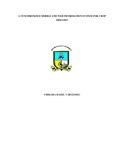Please use this identifier to cite or link to this item:
https://cris.library.msu.ac.zw//handle/11408/3910Full metadata record
| DC Field | Value | Language |
|---|---|---|
| dc.contributor.author | Chikara, Hazel | - |
| dc.date.accessioned | 2020-12-01T09:53:19Z | - |
| dc.date.available | 2020-12-01T09:53:19Z | - |
| dc.date.issued | 2017-11 | - |
| dc.identifier.uri | http://hdl.handle.net/11408/3910 | - |
| dc.description.abstract | Zimbabwe as an agro economic country focuses immensely on the profit from farming. The government has been investing heavily on the inputs that help make farming easy. The major reason for developing such a system is to impact expert information to farmers at a click of a button.. This document consists of the development of a software system that gives farmers expert information. This system is an easy to use intelligent system that captures the crop disease and give information about that crop and treatment recommendations of that crop. The system development went through phases where there was an introductory phase. This phase consists a background of past information defining a problem that rose for the system to be justified on development. There is aspersion of objectives and the aim of the project. Thereafter, a feasibility study which looks deeply in the question, “can this be done?” There is a deep investigation on the technical, social and financial reasons that determines the development of this software a go. After a feasibility study, an analysis is done, verifying the benefit and constraints that were and are there that justifies why there is need to develop a new system. It flags out the shortcomings of the existing system and poses the cheapest way to meet requirement. Thereafter, the actual logical design of the system is done, inputting the unified modelling language diagrams that gives a conceptual feel of the system. The system is then actually done in the implementation phase and results are made. The system then goes through a lot of testing, among them are system testing, defect testing etc. A deployment strategy is emanated that will ensure acceptance as well as full exploitation of the system. This is where there is verification of which changeover strategy should be implemented. For the product to be of a consistent flair, it needs to be monitored and evaluated. Maintenance, monitoring and evaluation of the system is also done flagging the preventative methods and reactive methods. From there, recommendations are passed to the users on how to ensure an optimised use of the system. The farmers were recommended to update their database since new information will continually be added. The researchers were urged to train the bot for better precision. The administrators were recommended to allow further developments and maintain the system. All stakeholders were recommended to have first read the user manual to familiarize themselves with the system. | en_US |
| dc.language.iso | en | en_US |
| dc.publisher | Midlands State University | en_US |
| dc.subject | mobile | en_US |
| dc.subject | web | en_US |
| dc.subject | information systems | en_US |
| dc.subject | crop disease | en_US |
| dc.title | A synchronized mobile and web information system for crop diseases . | en_US |
| dc.type | Thesis | en_US |
| item.openairecristype | http://purl.org/coar/resource_type/c_18cf | - |
| item.cerifentitytype | Publications | - |
| item.fulltext | With Fulltext | - |
| item.openairetype | Thesis | - |
| item.languageiso639-1 | en | - |
| item.grantfulltext | open | - |
| Appears in Collections: | Bsc Information Systems Honours Degree | |
Files in This Item:
| File | Description | Size | Format | |
|---|---|---|---|---|
| to wise final draft (Autosaved) (Autosaved).pdf | Full Text | 2.97 MB | Adobe PDF |  View/Open |
Page view(s)
72
checked on Jul 26, 2024
Download(s)
104
checked on Jul 26, 2024
Google ScholarTM
Check
Items in MSUIR are protected by copyright, with all rights reserved, unless otherwise indicated.


